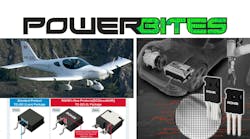Battery-Powered Aircraft May Make Flight Training Greener and More Affordable
Electric aircraft are drawing significant interest from flight schools worldwide, with at least two manufacturers already taking orders for their e-trainers. Although present-day battery technology only enables them to support relatively short flights, on the order of 50-70 minutes, they provide modern, reliable, and economical platforms for student pilots to complete their primary training.
The most recent entry into the e-trainer market is BRM Aero’s Bristell Energic (see figure). The Czech-built aircraft is a variant of the Bristell family of conventionally powered sport/trainer products.
The Energic is based on a modified version of the Bristell B23 airframe. Its rugged construction and optimized handling characteristics have made it a popular choice for flight schools throughout Europe.
Instead of the 100- to 140-HP Rotax powerplants used by the rest of the Bristell series, the Energic employs a 80-kw (90 kW peak) electric propulsion unit (EPU) manufactured by H55. The EPU includes an electric motor, its controller electronics, an inverter, and power electronics. The EPU is fed by an integrated 48-kWh energy storage system (ESS), also manufactured by H55.
Capable of cruising at speeds of up to 200 km/h (124 mph), and stalling at 87 km/h (54 mph), the Energic delivers a climb rate of 800 feet per minute while loaded to its maximum payload capacity of 180 kg (394 lbs). After a flight, the factory-supplied charger can bring the Energic’s batteries up to full capacity in 75 minutes. Under normal conditions, H55 says that the battery pack is expected to deliver 1,500+ flights before it needs replacement/refurbishment.
While pricing hasn't been announced, it's expected to be on par with a conventionally powered Bristell trainer, while offering significantly lower operating costs. Using electricity priced at $.20/kWh, a full charge costs $7, somewhere between 10% and 20% of the cost of the aviation-grade fuel a conventional trainer would burn during an hour’s flight.
Bristell recently announced that it anticipates the first deliveries of production aircraft to Europe will begin in 2026. Meanwhile, two prototype aircraft are presently operational and being used for certification tests as well as demonstration flights with potential customers.
The Energic will share the e-trainer market with at least one other European aircraft, the Pipistrel Velis Electro. Manufactured by Slovenia-based Pipistrel (now a division of Textron), the Electro’s 65-kW powerplant gives the aircraft a cruise speed of 200 km/h (124 mph) and a climb rate of 650 feet/minute while carrying its maximum-rated payload of 380 pounds (172 kg). Since it achieved its certification in 2020, over 100 Velis Electro aircraft have been delivered to customers in 30 countries worldwide, including the United States.






